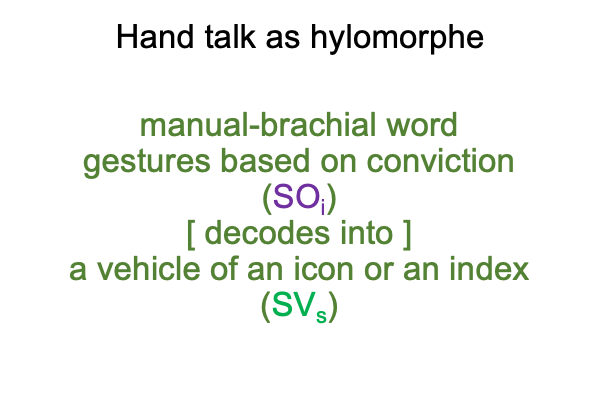0157 Now that I have arrived at a technical definition of the term, “meme”, within the framework of postmodern scholasticism, I may examine chapter nine of Dennett’s book (“The Role of Words in Cultural Evolution”) and chapter twelve (“The Origins of Language”).
0158 Dennett’s argument goes like this.
Words are a key ingredients to culture, because they belong to language. Spoken words make excellent examples of memes. Spoken words are like viruses.
But, I wonder, what about hand-talk words?
0159 Apparently, the idea that language evolves in the milieu of hand talk does not cross Dennett’s mind. Indeed, many evolutionary biologists treat culture, in general, and language, in particular, as the actuality independent of the adapting species2a, rather than an adaptation2b. Why? They are convinced that humans have no ultimate niche, only a blend of proximate niches, all of which offer material or instrumental advantages or challenges.
0160 Au contraire.
According to the masterwork, The Human Niche (by Razie Mah, available at smashwords and other e-book venues), our lineage adapts to an ultimate niche1b, the potential1b of triadic relations2a, as well as diverse proximate niches, including various Pliocene and Pleistocene ecologies and environments.
Practical language2b is an adaptation to team activities and contributes to the expansion of the hominin neocortex between 2000kyr (thousands of years ago) and 800kyr. Hand talk evolves from pantomime to rudimentary (team-specific) grammars.
General language2b is an adaptation that evolves within the milieu of hand talk, after the domestication of fire, around 800kyr (800 thousand years ago). Hand talk evolves from rudimentary team-specific languages to fully grammatical general languages.
Here is a picture of the latter step.

0161 What is language in the milieu of hand talk?
Hand-talk consists of manual-brachial gestures. Manual-brachial gestures work (that is, have the character of memes) because they picture or point to their referents. In terms of semiotics, manual-brachial gestures are icons and indexes.
When these are routinized, symbolic processing starts to occur, enhancing the distinctiveness of each gesture, and turning each into a word-gesture in a system of differences. The modern linguist, Ferdinand de Saussure (1857-1913 AD) defines “spoken language” as two arbitrarily related systems of differences, parole (speech) and langue (mental action). A finite system of differences (for Saussure) is a symbolic order (for Peirce). Grammar consists of operations within a symbolic order.
In hand talk, the relation between parole and langue is motivated by the natural sign characteristics of hand-talk words. Manual-brachial gestures are icons and indexes. Gestures image and indicate their referents. At the same time, hand talk also routinizes gestures into words. Words operate as symbols. They form a symbolic order. A symbolic order allows grammar. Grammar makes hand talk linguistic.
0162 Our ancestors never imagine that their gesture-words are icons, indexes or symbols.
Nevertheless, they become better and better at hand talk.
0163 How do manual-brachial word gestures fit the definition of meme?
A perspective-level actuality2c may be a conviction that cannot be explicitly expressed using iconic and indexal signs. After all, how can a hand-talk word point to or picture a species impressa2a, a species expressa2b or a species intelligibilis2c?
Nevertheless, the conviction2c is real. Plus, if the hypothesis proposed in The Human Niche is credible, and if the scholastic interscope for how humans think describes what it claims to describe, then conviction2c is an adaptation.
So, how do our ancestors express their convictions2c?
They express their convictions through hand-talk expressions2a (SOi) in the normal context of what is happening3a and with the potential of ‘something’ happening1a (SIi).
Then, the hand-talk words2a are linguistically decoded into an icon or index (SVs).
0167 Here is a picture of hand-talk as a meme.

0168 Before general language, the practical hand-talk languages of each team activity are distinct and only occur within the normal context of each team activity. Many of the characteristics that we associate with spoken words remind me of how hand-talk languages adapt to the crucible of team activities.
During the team activity, conviction2c judges whether the ongoing content-level normal context of what is happening3asupports the ongoing situation-level normal context of what this means to me3b. This conviction2c (SVi) substantiates hand-talk words (SOi) that either maintain the situation-level potential1b in the face of content-level potentials1a or not.
0169 For example, we don’t gather mushrooms at locations where lions are known to prowl. Plus, when a lion is nearby, everyone wants to get back to the band. There are hand-talk words that convey these tidbits of semantic information. We expect that our words refer to things and states of things. We expect our words to be honest. We insist that certain words are used appropriately. We expect words to contribute to our awareness of the ongoing situation. We expect words to convey, sometimes with comic zeal, what is happening and what it means to me.
0170 So, is there a problem with this scenario?
Have you noticed that no one talks with their hands anymore?
According to the masterwork, An Archaeology of the Fall (by Razie Mah, available at smashwords and other e-book venues), around 7800 years ago, the only culture on Earth practicing speech-alone talk is the Ubaid of southern Mesopotamia. All other Epipaleolithic, Mesolithic and Neolithic cultures practice hand-speech talk.
0171 Why?
For one, speech is added to hand talk at the start of our species, before 200kyr. Our human ancestors practice a dual mode of talking, hand-speech talk, for over 190 thousand years. Then, the first singularity occurs.
For two, the first singularity starts with the Ubaid of southern Mesopotamia. Today, all civilizations practice speech-alone talk. In fact, every civilization throughout history practices speech-alone talk, raising the question, asking, “Did the adoption of speech-alone talk potentiate civilization?”
For three, the answer is yes.
0172 Here is a picture of speech-alone talk as a meme.

The difference between hand-talk words and speech-alone words may seem subtle. Nevertheless, the difference is substantial.
0173 Hand-talk and hand-speech talk facilitate constrained social complexity.
Speech-alone talk potentiates unconstrained social complexity.
